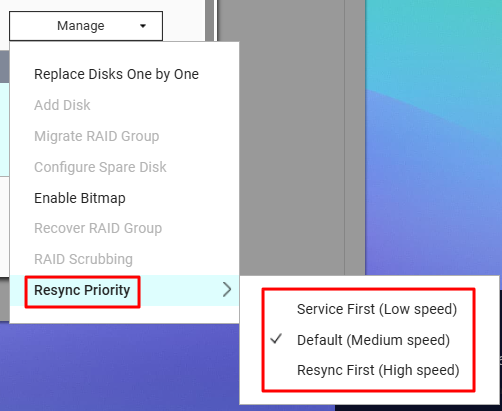How does RAID synchronization differ when I build a storage pool in QTS compared to QuTS hero?
Last modified date:
2025-10-15
Applicable Products
- NAS (QTS / QuTS hero)
Overview
This FAQ compares RAID synchronization times when creating a storage pool in QTS (using mdadm) and QuTS hero (using ZFS). It outlines architectural differences affecting synchronization speed and provides guidance for optimal setup.
- QTS (mdadm-based RAID): When you create a new RAID 1 volume, QTS uses the Linux mdadm utility, which performs a full initial synchronization (resync) of all data blocks, ensuring both drives are identical—even if no data has been written yet.
- QuTS hero (ZFS-based): QuTS hero uses ZFS, which only synchronizes data blocks as they are written. No lengthy initial resync is required for empty or newly created pools.
QTS RAID synchronization
- When you create a new RAID 1 group in QTS, the system uses the Linux mdadm utility to perform a full initial synchronization (resync) of all data blocks, even if no user data exists yet. This ensures both drives are fully identical.
- The RAID group is usable immediately, but performance may be reduced until resync finishes.
- To minimize delays, avoid heavy write operations during synchronization.
- Monitor the synchronization process via Storage & Snapshots > Storage/Snapshots > Storage Pool Management.
- You can adjust Resync Priority (Service First, Default, Resync First) to control sync speed versus system responsiveness.

QuTS hero RAID synchronization
- QuTS hero uses ZFS, which initializes mirrored pools quickly—no full-disk initial resync is required. Only data that you actually write is checked and mirrored.
- If Optimize Performance is enabled during pool creation (default setting), the pool may be unavailable until optimization completes. This usually takes only a few minutes.

- ZFS automatically performs scrubs (background data integrity checks) and resilvering(rebuilding redundancy after a disk replacement), processing only data that actually exists, not the whole disk.
- Scrub: Verifies data integrity during normal operation.
- Resilver: Synchronizes new or replacement disks, but only used data is processed.
Recommendation
- Use identical disks (size and type) within a RAID group for best performance and compatibility.
- Minimize heavy workloads during RAID synchronization or initialization to reduce total sync time and avoid potential slowdowns.
- Regularly monitor the health and status of your storage pool using the management interface.





